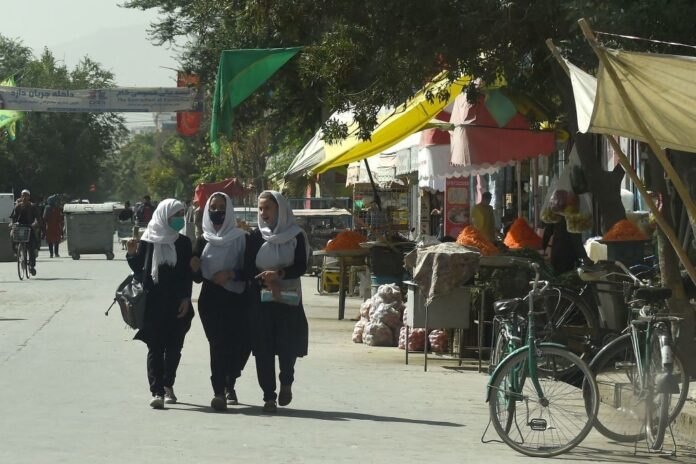KABUL: Afghanistan’s new Taliban rulers have said girls will be allowed to go to school as they seek to show they have changed since last in power 20 years ago when girls were reportedly barred from education.
But many do not believe them, among them the founder of a girls’ school in Kabul, who has burnt all her students’ records to protect them from possible reprisals.
Even if the Taliban keep their word on schooling, many people are concerned that girls’ education and future opportunities will be restricted under the militant group’s rule.
How has girls’ education changed since 2001?
The Taliban banned almost all education for girls during their 1996-2001 rule.
After the insurgents were ousted, school attendance rose rapidly, with more than 3.6 million girls enrolled by 2018 — more than 2.5 million in primary school and over 1 million in secondary.
The increase in girls in secondary education was particularly marked, with nearly 40 percent enrolled in 2018 compared with 6 percent in 2003, according to the UN children’s agency, UNICEF.
The number going to university, now in the tens of thousands, has also jumped. Some are studying to become doctors, lawyers, scientists and journalists, and Kabul University has even launched a master’s degree in gender and women’s studies.
Nonetheless, the country has one of the biggest education gender gaps, with UNICEF saying girls account for 60 percent of the 3.7 million Afghan children out of school.
Only 37 percent of teenage girls can read and write, compared to 66 percent of boys, according to Human Rights Watch.
Government data suggests a third of girls are married by the age of 18 and nearly 9 percent by 15.
What have the Taliban said?
The Taliban have said girls will be able to go to school in line with their law — without clarifying exactly what that means.
They have said education must be single-sex and that girls can only have female teachers.
Although many schools remain shut since the militants seized power this month, the Taliban have shared video clips on social media showing girls returning to class.
UNICEF has expressed cautious optimism about working with Taliban officials.
In December, it struck a deal with the Taliban to establish informal schools for up to 140,000 children, including girls, in areas controlled by the group.
Why are people worried?
Some fear girls’ schooling will be restricted to religious education.
The Taliban have said girls will not be allowed to go to school with boys, but only 16 percent of Afghan schools are currently girls-only, according to UNICEF.
There are also not enough female teachers in Afghanistan for gender-segregated classes.
Only a third of teachers are female, according to UNICEF, and the proportion is much lower in rural areas and above the primary level.
Just 10-15 percent of female teachers are properly qualified, and — as thousands of people flee the country following the Taliban takeover — there are fears that many of the best women teachers could leave.
There are question marks over secondary and tertiary education too. Schools in parts of the country that were already controlled by the Taliban do not teach girls aged over 12.
Taliban have also targeted and threatened girls’ schools in recent years. One girl told Time magazine how the Taliban had sent burial shrouds to her school in Herat province, saying “any girl continuing school will wear these”.
A Taliban official said in August that women would be allowed to study at universities, but could not share classes with men or be taught by male teachers. This could have implications for courses where there are not enough female teachers.
However, photos on social media in September showed male and female students at Avicenna University in Kabul sitting in the same classroom separated by a curtain down the middle.
A Taliban official told Reuters that classroom dividers were acceptable and that given Afghanistan’s limited resources it was best to have the same teacher for both sides.
Teachers and students in Afghanistan’s largest cities said female students were also being taught separately in some cases or restricted to certain parts of the campus.
What about rural areas?
While 70 percent of girls attend primary school in urban areas, only 40 percent do so in rural areas, according to the Center for Global Development.
The difference between urban and rural boys is much smaller.
Traditional attitudes around girls, poverty, safety concerns and transport difficulties are common reasons why rural families keep their daughters out of school.
A Taliban ban on mixed schools could exacerbate the gender gap in some provinces where only one in 10 teachers are female.
What do teachers think?
Shabana Basij-Rasikh, the founder of Afghanistan’s first girls’ boarding school, said this month she had burnt her students’ records to protect them, and moved her school to Rwanda, which has offered them a temporary home.
Basij-Rasikh pointed out the irony that when the Taliban were last in power they had burnt all-female students’ records, hers included, “to erase their existence”.
Education activist Pashtana Durrani is also sceptical of Taliban promises.
“They have to walk the talk. Right now they’re not doing that,” she told Reuters this month.
Another teacher, who runs a religious school for girls, said the Taliban were aware women could not be silenced.
“They will have to accept who we are and what we have become,” she added.
Can the Taliban turn back the clock?
Humanitarian experts noted that the Taliban are taking over in very different circumstances compared with two decades ago.
In 1996, the country was devastated by civil war, a generation had grown up with little or no education, and most educated Afghans had left.
Donors have since poured billions of dollars into education, with the rise in girls’ education often highlighted as a success. Many former refugees have also returned, having been educated abroad and exposed to a wider world view.
Support for girls’ education remains high in Afghanistan, with 87 percent in favour, according to a 2019 survey by the Asia Foundation.
But even if the Taliban make good on their pledge to let girls study, experts say the militants’ underlying philosophy has not changed, making it unlikely that women will be able to pursue careers and engage in public life.
What about donors?
With many people displaced by drought and conflict, the Taliban are likely to need aid agencies to continue delivering basic services funded by donor money.
Foreign powers, who want the Taliban to respect the rights of women in return for aid and diplomatic engagement, are closely watching what happens in universities and schools.
Gordon Brown, the UN Special Envoy on Global Education, has said donors should continue to fund Afghan schools as long as they remain open to girls.
They should also require proper security around school gates “to ensure girls don’t have to fear entering a classroom”.























